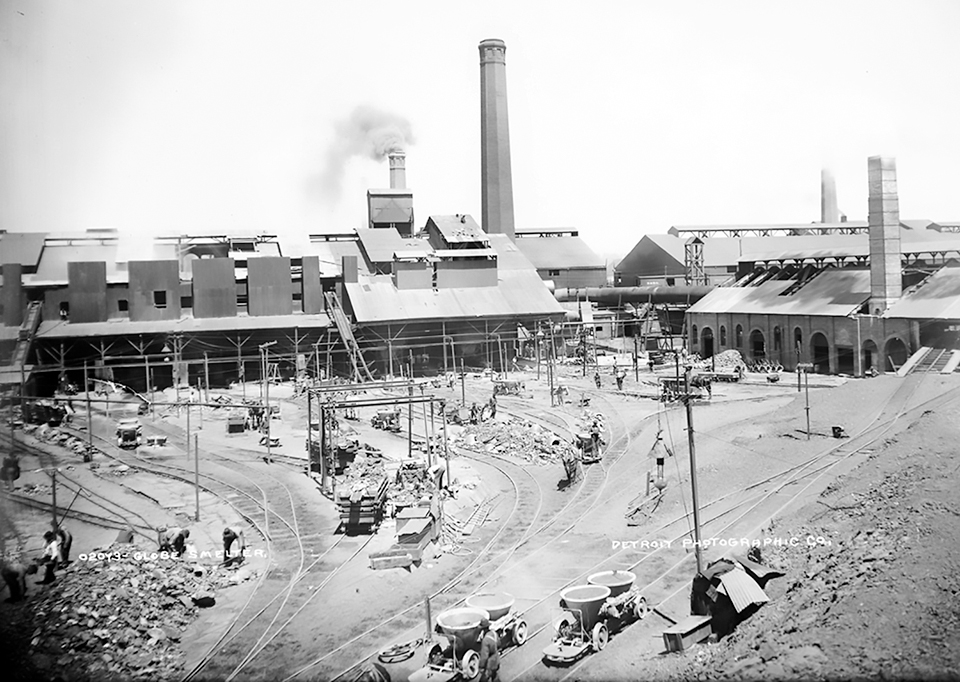
Crossroads Commerce Park sits on the crest of the southwest corner of 55th Avenue and Washington Street. Its sparkling new offices and warehouses cover 1 million square feet, and are surrounded by smooth asphalt parking lots and colorful landscaping. There is no plaque, no historical marker to show that this was once the site of the mighty Globe Smelter.
The working class neighborhood at the bottom of the hill features modest houses, cozy yards, church spires, and small businesses. Globeville is a diverse community of blue collar workers striving to provide a good living for their families.
Goliath
Smelters separate valuable metals like gold, silver, lead, copper, and zinc from raw ore. They were big business and, between 1890 and 1900, accounted for two-fifths of Colorado’s economy. There were three large smelters near Globeville: The Boston and Colorado (1878), the Omaha and Grant (1882), and the Globe Smelter, incorporated in 1889. Immigrants from Eastern Europe and Russia sought jobs in the smelters because the twelve hour days and the heat, dust, and chemicals seemed better than starvation in the old country.
In 1899, two of Globeville’s smelters, the Grant and Globe, joined the smelter trust, the American Smelting and Refining Company (ASARCO), with its headquarters in New York City. ASARCO controlled two-thirds of the nation’s smelting and refining capacity, with 16 smelting plants and 18 refineries nationally. It also had power over labor, standardizing wages and keeping union agitators in check.
But this Goliath struggled. The Grant Smelter closed in 1903, and the fire-damaged Boston and Colorado Smelter was dismantled by 1910. In 1919, ASARCO discontinued smelting at the Globe and began extracting what was useful from the flue dust,
including cadmium.
During World War II, the 150 employees of the Globe plant supplied nearly 60 percent of the nation’s cadmium. Used to coat airplanes, bearings, and radio equipment, the rust-proof element was considered essential to the nation’s defense.
Following the war, the Globe’s workforce included many Spanish-surnamed employees. The plant was considered a safe place to work, winning safety awards from the
National and Colorado Safety Councils. That perception would soon change.
Changing Times, Changing Rules
In the mid-1960s, the fledgling environmental movement generated an awareness of the impact of chemicals in the workplace. The passage of the Occupational Safety and Health Act (OSHA) of 1970 redefined the criteria for safety including exposure to chemicals and airborne particulates as well as the proximity of industries to neighborhoods. Eventually, employees and neighbors of the Globe Plant would grow alarmed.
In 1977, the Colorado Occupational Safety and Health (COSH) found concentrations of airborne cadmium as much as 15 times higher than the new legal maximums. It would be the beginning of nearly two decades of tests, studies, reports, fines, shifting responsibility, and increasing concern about the health of Globeville’s citizens.
Throughout the 1980s, there would be more testing, reports and investigations presented to the public. As 1990 came to an end, it seemed to the residents that everyone was content as long as studies were being conducted. Some people had had enough.
Here Comes David

On August 21, 1991, 568 property owners of Globeville served ASARCO with a lawsuit charging that the firm had contaminated soil, lowered property values, and endangered health. Margaret Escamilla explained, “the state told us that the lead, cadmium, and arsenic released by ASARCO created only a small risk. We didn’t believe them.”
In February 1993, the lawsuit initiated by Margaret and Robert Escamilla came to trial, represented by a team of lawyers led by attorney Macon Cowles.
Drawing upon increasing public awareness that toxic emissions and waste were generally located in low-income neighborhoods, the attorneys made a case for environmental justice and environmental racism.
The strategy was successful. On March 12, 1993, Denver District Judge Morris B. Hoffman awarded a historic $28 million to 568 Globeville property owners. The jury then decided property owners were entitled to $12 million for reduced property values.
“The little guy came out on top,” said Robert Escamilla. “We’re just sending a message … that the people don’t have to tolerate it.”
In 1997, Lalo and Eumelia C. de Baca and 390 property owners and renters on Globeville’s south side filed a lawsuit and received $12 million from ASARCO.
Goliath Stumbles
On August 9, 2005, ASARCO filed for protection under Chapter 11 Bankruptcy and closed its plant in Globeville, hoping to sell the property.
Progress stalled during the national recession in 2008, but resumed in October 2011 when a brownfield company, EnviroFinance Group, bought the site and began demolition, disposal, and remediation. In October 2014, Denver developer Trammell Crow bought the site and developed an
industrial park.
Crossroads Commerce Park has erased any remnant of the smelting industry that once drove the economy of Colorado and defined the community. Perhaps there should be some recognition of the Davids that initiated this transformation.
Mary Lou Egan is a fourth-generation Coloradan who loves history and is working on a history of Denver’s Globeville neighborhood. Her blog http://globevillestory.blogspot.com contains tidbits about the community. You can reach her at maryloudesign@comcast.net

Golly, Mary Lou it you’re still looking for “any remnant of the smelting industry” maybe check out the brownfield across the street. Curious how you eliminate the community of Globeville form the name “Crossroads Commerce Park at Globeville”. Perhaps you’re the one leaving out some recognition…
Bernie,
I was speaking specifically of the ASARCO Globe Plant and the triumph of the Escamilla’s and C. de Baca lawsuits for Globeville.